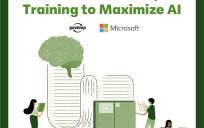It seems like every time you turn around these days someone is talking about big data. Big data is changing the way we live and work as people find correlations between things that in years past would have never been connected. While I have no doubt that the way that big data has a big role to play in helping organizations look at the enormous complexity of their operations I think people often miss the mark in their planning by not focusing on “little data.” What is “little data?”— it’s that Thin Layer of information that makes a difference when it comes time to make decisions for our organization.
Little data is the stuff you absolutely have to know because it drives organizational decision making. It’s little because while the volume of information that could be and is captured in most organizations is huge, most of it is just noise. It is crowding out the stuff that really matters. The things that help you make decisions every day about investments, programs, projects and resources. The Thin Layer is difference making information, its three columns from one spreadsheet and four from another. It is the things you absolutely have to get right in order to steer the ship. In your search for the Thin Layer you should avoid simply accepting all the default columns on the management report. People only have so much mental space…use it wisely!
In the same fashion organizations only have so many resources so use them wisely as well. Don’t spend time and effort processing unnecessary data, building unnecessary reports, or managing data quality on things that don’t matter. That time and effort is better put to the decision making itself. One of the biggest failures I see in decision support is that people spend so much time gathering information and building the decision making process that they never actually get to making the decisions.
Building the Thin Layer of Information that Really Matters
- If you haven’t already figure out your information marketplace, start by figuring out what the critical decisions are in your organization.
- Once you know what decisions need to be supported its time to figure out who needs to be involved.
- Work with the decision makers to decompose thise decisions into the information you need to support those decisions. Hint: They probably already have some reports they are using now to support decision making.
- Identify the sources of information required to support the decisions and an approach to gathering it consistently and accurately. Accuracy is critical!
- Pull it all together including the people, processes, technology and information.
- Make decisions using the information to drive them. The whole point of this exercise was making better data driven decisions. It only works if you actually use it.
- Measure results. This can be tricky, but understanding the outcomes of your decision making helps drive the next iteration of your decision making process.
- Make changes. Decision making processes are living things and need updating in order to be successful. Make sure you are capturing your outcomes so you can update your processes accordingly.
- Every once in awhile repeat the entire process. As your organization changes you are going to have new decisions to support and new people to work with in order to support them. Having an annual or other regular time frame for re-evaluating your information environment is critical to long term organizational growth.





Leave a Reply
You must be logged in to post a comment.